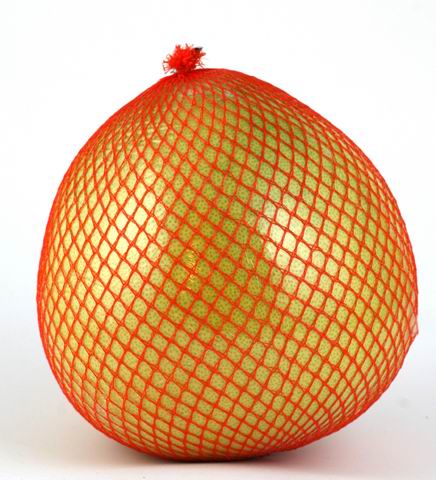Although Christmas is over, there’s still something special you may want to unwrap, and it coincides with the upcoming two-week celebration of Chinese New Year that starts January 26.
As part of Chinese New Year festivities, special foods are not only eaten, but also used to decorate homes as a sign of prosperity, and to bring good fortune. One such food is the pummelo (PUHM uh loh) also known as Chinese grapefruit or shaddock.
A pummelo looks like a grapefruit gone wild, growing up to 12 inches in diameter and weighing up to 25 pounds. Its skin casts a shade of pale green covering its shape, which varies from round to spherical to pear. As the great granddaddy of grapefruit, the pummelo is the oldest and largest of citrus fruits.
Having a pummelo is like getting a gift in the mail. It comes with a lot of wrapping. And once you finally uncover it, it may not be something you always wanted nor something you always want, but definitely something you can immensely enjoy every little once in a while.
Like any unusual gift, the first thing you might ask is, “What do I do with this thing?” Good question. The size is intimidating and makes you wonder if you should keep it to serve at a block party or banquet.
Once you remove the cello and mesh casing, give the fruit a good washing. It’s travelled a long way (from Asia, the Caribbean or Florida) and needs some freshening up.
Slice the top and bottom with a serrated knife and set flat-side down on a plate. Place one hand on the top of the fruit to stabilize while using a paring knife to score the skin and pith. Slowly turn the fruit in a circle while angle-cutting the skin from top to bottom. You’ll notice that the first cut is the sweetest, as the pummelo emits a fine mist of refreshing citrus scent. Peel off the skin and set aside for making marmalade or candied peel if you like.
Beneath the skin, the pummelo is heavily insulated with thick, spongy pith resembling cotton batting. (I contemplated saving it for a quilt.) Once the pith is peeled away revealing 16 to 18 sections of fruit, separate the sections, then use the paring knife to slice through the membranes to remove the delicious fruit. Some pummelos have large seeds which also need to be removed.
If this sounds like too much work, you can take the easy way and slice the pummelo like an orange. This method will produce some large, unwieldly wedges, but it is fast and simple. Keep in mind the membrane is thick, so you have to work your teeth through to try and coax out as much fruit and juice as you can. With the pith and membrane intact, the taste will be slightly bitter or lemony, which some people may enjoy.
The flesh, which ranges in colour from pale yellow to deep pink, is not as juicy or acidic as other citrus fruits. Pummelos taste similar to grapefruit, but are sweeter, with no bitterness. As the flavours can vary from fruit to fruit, sometimes a hint of lychee or peach can be detected. Aside from eating fresh, pummelo can be added to salads, jams, chicken and pork dishes, and juices.
Although it keeps well at room temperature for about a week, after recently watching the 1978 version of ‘Invasion of the Body Snatchers,’ my pummelos are immediately confined to the fridge, and then eaten before anyone falls asleep. But rest assured, pummelos will keep refrigerated for up to two weeks.
When selecting your pummelo, check for greenish skin that is smooth, blemish-free and has an aromatic scent. Ensure it is firm and heavy for its size as this will indicate juiciness. Lighter pummelos tend to be older, less juicy and flavourful, with sections that are difficult to separate.
A half-cup of pummelo has only 36 calories and 97% of the daily-recommended amount of vitamin C. Pummelos also contain antioxidant properties, and are a good source of potassium. Pummelo skin is used medicinally in some cultures along with the pummelo trees’ leaves and flowers to treat epilepsy and persistent cough.
With all the peeling, pith-removal, membrane-slicing and seed-plucking before you even get to the fruit, the pummelo may be a victim of its size and packaging, getting passed over for the more manageable grapefruit. Although it may be a bit time-consuming and cumbersome to prepare, this fine fruit is well worth the wait.

